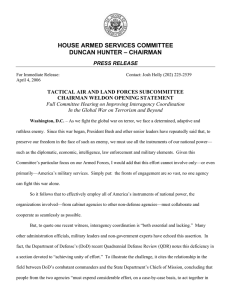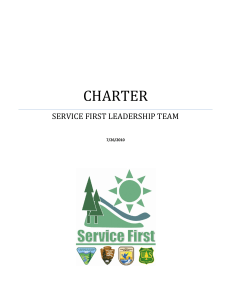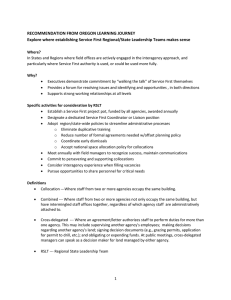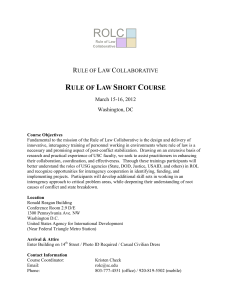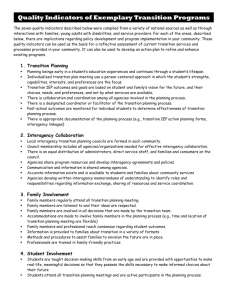Worksheet for Interagency Collaboration Practices July 2003 Paula D. Kohler, Ph.D.
advertisement
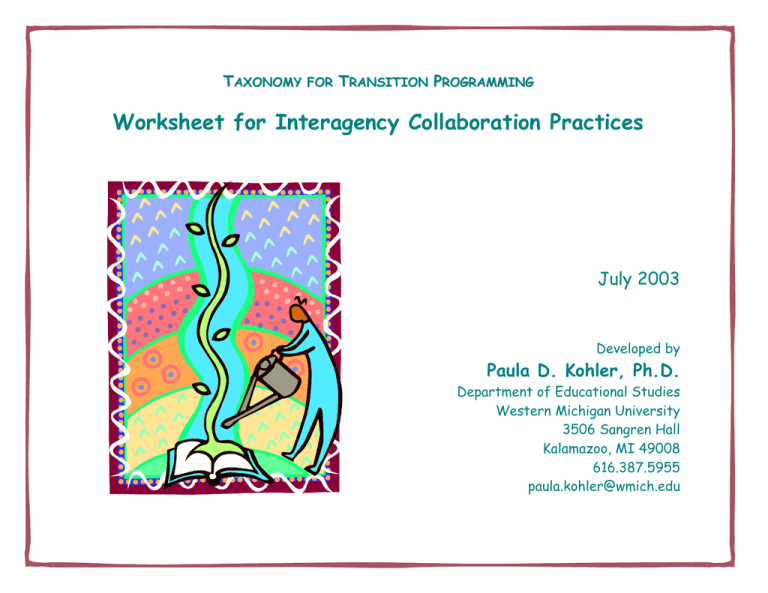
TAXONOMY FOR TRANSITION PROGRAMMING Worksheet for Interagency Collaboration Practices July 2003 Developed by Paula D. Kohler, Ph.D. Department of Educational Studies Western Michigan University 3506 Sangren Hall Kalamazoo, MI 49008 616.387.5955 paula.kohler@wmich.edu TAXONOMY FOR TRANSITION PROGRAMMING WORKSHEET FOR INTERAGENCY COLLABORATION PRACTICES Worksheet Overview .................................................................................................................................................................................................. 2 Team Information ............................................................................................................................................................................................... 2 Interagency Collaboration Practices in the Taxonomy for Transition Programming ......................................................................................... 4 Part 1 – Interagency Collaboration Practices Implementation Assessment ..................................................................................................... 5 Part 2 – Interagency Collaboration Practices Needs Assessment ....................................................................................................................... 9 Part 3 – Planning Interagency Collaboration Practices ....................................................................................................................................... 12 Checklist for Identifying and Evaluating Program Goals, Activities, Outputs, and Outcomes ............................................................. 19 This resource developed by: Paula D. Kohler, Ph.D. Department of Educational Studies Western Michigan University 3506 Sangren Hall Kalamazoo, MI 49008 269.387.5955 paula.kohler@wmich.edu http://homepages.wmich.edu/~kohlerp Worksheet for Interagency Collaboration Practices 1 WORKSHEET FOR COLLABORATION PRACTICES TEAM INFORMATION Team Name: ___________________________________________ Team Member: _________________________________________ Primary Contact: ________________________________________ Position: _______________________________________________ Organization: ____________________________________________ Address: ________________________________________________ Position: _______________________________________________ Organization: ____________________________________________ Address: ________________________________________________ _______________________________________________________ _______________________________________________________ Phone: _____________________ Fax: _______________________ E mail: _________________________________________________ Phone: _____________________ Fax: _______________________ E mail: _________________________________________________ Team Member: _________________________________________ Position: _______________________________________________ Organization: ____________________________________________ Address: ________________________________________________ _______________________________________________________ Phone: _____________________ Fax: _______________________ E mail: _________________________________________________ Team Member: _________________________________________ Position: _______________________________________________ Organization: ____________________________________________ Address: ________________________________________________ _______________________________________________________ Phone: _____________________ Fax: _______________________ E mail: _________________________________________________ Team Member: _________________________________________ Position: _______________________________________________ Organization: ____________________________________________ Address: ________________________________________________ _______________________________________________________ _______________________________________________________ Phone: _____________________ Fax: _______________________ E mail: _________________________________________________ Team Member: _________________________________________ Organization: ____________________________________________ Address: ________________________________________________ _______________________________________________________ Phone: _____________________ Fax: _______________________ E mail: _________________________________________________ To include all members, use back of page if necessary Worksheet for Interagency Collaboration Practices 2 WORKSHEET OVERVIEW This worksheet focuses specifically on the Interagency Collaboration Practices within the Taxonomy for Transition Programming, such as establishing structures and frameworks for collaboration and implementing collaborative service delivery at the individual and community levels. We suggest you use a team approach to reflect on the extent to which and how you currently implement these practices, determine strengths and needs, and develop specific goals to address your needs. This worksheet is designed to help guide you through this process. Use Part 1— Interagency Collaboration Practices Implementation Assessment, to reflect on the degree to which you are implementing the specific practices. To assist with this reflection, we provide a set of questions and indicators that focus on each practice area. Indicators marked with a are required by the Individuals with Disabilities Education Act (IDEA). These questions are designed to help you go beyond simple “yes” or “no” answers as you rate your implementation levels and identify the evidence that supports the selected rating level. In Part 2— Interagency Collaboration Practices Needs Assessment, use your findings from Part 1 to identify your strengths and specific needs. Subsequently, prioritize your needs and use Part 3—Planning Interagency Collaboration Practices to develop plans that address them. Remember that the purpose of these efforts is to improve student outcomes. Thus, one’s efforts must begin and end with the knowledge of what students are achieving after leaving high school. The questions included herein focus primarily on educational processes and services, designed to provide students with the skills they need to live and work independently. Specific reflective questions focused on students’ post-school outcomes are listed below. They should guide your reflection and provide the basis for all your educational and transition programs and services. Reflective Questions Regarding Students’ Outcomes Regarding short-term outcomes, do your students have the skills they need to be successful Academic skills? Independent living skills? Occupational skills? Work behaviors? Self-determination skills? Regarding long-term outcomes, are your students Employed? Living independently? Participating in their communities? Do your students have the educational and community supports and services they need to be successful? Worksheet for Interagency Collaboration Practices 3 TAXONOMY FOR TRANSITION PROGRAMMING STUDENT-FOCUSED PLANNING STUDENT DEVELOPMENT FAMILY INVOLVEMENT PROGRAM STRUCTURE INTERAGENCY COLLABORATION Collaborative Service Delivery Coordinated requests for information (e.g., to parents, employers) Reduction of system barriers to collaboration Collaborative funding and staffing of transition services Collaborative development and use of assessment data Coordinated and shared delivery of transition-related services Systems information disseminated among cooperating agencies Collaborative program planning and development, including employer involvement Collaborative consultation between special, “regular,” and vocational educators Collaboration between post-secondary education institutions and the school district Worksheet for Interagency Collaboration Practices Collaborative Framework Interagency coordinating body that includes consumers, parents, service providers, and employers Formal interagency agreement Roles of service providers clearly articulated Established methods of communication among service providers Student information shared among agencies via established procedures (with appropriate release of information and confidentiality) Single-case management system “Lead” agency identified Designated transition contact person for all service providers 4 PART 1: INTERAGENCY COLLABORATION PRACTICES IMPLEMENTATION ASSESSMENT Use the following Implementation Level Rating Scale to determine the appropriate implementation level for each practice area. Also describe evidence that illustrates the practice is being implemented at the level indicated. Use the reflective questions and suggested indicators to help clarify and expand the reflective process. The reflective questions are designed to help you go beyond simple “yes” and “no” responses and substantively reflect on the degree of implementation in each practice area. The questions and indicators also help provide examples of evidence you might examine to determine the implementation level. An example is provided. Implementation Level Rating Scale DK 1 2 3 4 - I don’t know the status of development or implementation in this area No activities have been developed or implemented in this area Activities are in development, but have not yet been implemented Activities are in development and have been partially implemented Activities are fully implemented Example: Taxonomy Practices Circle Current Implementation Level Evidence of Implementation INTERAGENCY COLLABORATION 1. Formal collaborative agreements and structures are established among schools, employers, human service agencies, and post-secondary institutions through which roles and responsibilities are clearly articulated, including: a. methods of communication, b. information sharing protocols, c. referral protocols, d. service and task responsibilities, e. funding responsibilities, and f. points of contact Part 1: Interagency Collaboration Practices Implementation Assessment DK 1 2 3 4 District-level memorandum of understanding (MOA) in place that outlines roles and responsibilities of education, agency, and postsecondary organizations and staff. 100% of partners have designated contact with transition-related scope of work. Community level team meets monthly. Agendas on file, attendance records maintained. Attendance rate of partner agencies is 95%. Annual evaluation indicates overall satisfaction and specific areas for improvement. 5 INTERAGENCY COLLABORATION PRACTICES 1. Formal collaborative agreements and structures are established among schools, employers, human service agencies, and post-secondary institutions through which roles and responsibilities are clearly articulated, including: IMPLEMENTATION EVIDENCE OF IMPLEMENTATION DK 1 2 3 4 a. Methods of communication, b. Information sharing protocols, c. Referral protocols, d. Service and task responsibilities, e. Funding responsibilities, and f. Points of contact. Reflective Questions: How many schools have up-to-date collaborative agreements with their local service agencies, employment agencies, youth development programs, etc.? What agencies and/or organizations are included in the agreements? Are formal meetings held? How often? Is information available and disseminated regarding agency services, eligibility requirements, and referral protocols (e.g., regional or local directory)? How and to what extent do various educators and service agencies coordinate, collect, and share assessment information? Suggested Indicators # and content of agreements Action plans; assessment results of action plan implementation Meeting agendas; attendance rates Agency information products Dissemination records Agency fairs: # participants, # attendees, attendee satisfaction Part 1: Interagency Collaboration Practices Implementation Assessment 6 INTERAGENCY COLLABORATION PRACTICES IMPLEMENTATION 2. Educators, service providers, and employers work together to identify and address transition education and service needs of individual students. DK 1 2 3 4 EVIDENCE OF IMPLEMENTATION Reflective Questions How are students’ service needs determined and communicated? To what extent do rehabilitation counselors, human service agents, and/or other relevant service providers actively participate in ICP and/or IEP meetings? To what extent do rehabilitation counselors, human service agents, and/or other relevant service providers meet with students in schools? How many students are receiving rehabilitation and/or other services? What services are they receiving? Suggested Indicators Record of student service needs identified by students, parents, educators, service providers # of service providers invited to IEP meetings # and role of service providers attending IEP meetings Student support needs identified in the IEP Interagency responsibilities and/or needed linkages identified in students’ IEPs # students referred for agency services # students receiving services # students enrolled in career and technical education Part 1: Interagency Collaboration Practices Implementation Assessment 7 INTERAGENCY COLLABORATION PRACTICES 3. Educators, service providers, and employers work together to identify and address school and community level transition education and service issues, including program development and evaluation. IMPLEMENTATION EVIDENCE OF IMPLEMENTATION DK 1 2 3 4 Reflective Questions How are businesses and labor unions recruited as partners? How are businesses and labor unions involved in identifying standards, developing curricula, participating in career awareness and exploration, providing work-based education, and providing professional development for teachers? Are local businesses and labor unions satisfied with students’ current educational outcomes? How do vocational and special educators communicate regarding student support needs in occupational classes or programs? How are community-level transition service needs identified? What services do students need but are not getting? How many and what services are projected for the future? Suggested Indicators Record of recruitment activities # and description of business/community partners Program advisory committee agendas and minutes Community partner survey data (needs and/or satisfaction) Collaboration protocols or action plans Meeting records # and type of projected service needs # and type of unmet needs Part 1: Interagency Collaboration Practices Implementation Assessment 8 PART 2: INTERAGENCY COLLABORATION PRACTICES NEEDS ASSESSMENT Instructions Use the responses on your Interagency Collaboration Practices Implementation Assessment to identify the current strengths of your transition-focused education and services for all youths. Then use this information as a baseline to identify specific education or service needs. Subsequently, use highlighters to color-code your identified needs with respect to their immediacy, or the order in which they might be addressed: (a) pink - immediate, (b) yellow - intermediate, and (c) blue - long-term. INTERAGENCY COLLABORATION PRACTICES CURRENT STRENGTHS NEEDS 1. Formal collaborative agreements and structures are established among schools, employers, human service agencies, and post-secondary institutions through which roles and responsibilities are clearly articulated, including: a. methods of communication, b. information sharing protocols, c. referral protocols, d. service and task responsibilities, e. funding responsibilities, and f. points of contact. Part 2: Interagency Collaboration Practices Needs Assessment 9 INTERAGENCY COLLABORATION PRACTICES CURRENT STRENGTHS NEEDS 2. Educators, service providers, and employers work together to identify and address transition education and service needs of individual students. Part 2: Interagency Collaboration Practices Needs Assessment 10 INTERAGENCY COLLABORATION PRACTICES CURRENT STRENGTHS NEEDS 3. Educators, service providers, and employers work together to identify and address school and community level transition education and service issues, including program development and evaluation. Part 2: Interagency Collaboration Practices Needs Assessment 11 PART 3: PLANNING INTERAGENCY COLLABORATION PRACTICES Instructions The purpose of this section is to help you make plans for the coming year. Use the responses from your Part 1—Interagency Collaboration Practices Implementation Assessment and Part 2—Interagency Collaboration Practices Needs Assessment to identify specific goals that address your identified needs. Then identify specific goal-related activities, the person(s) responsible for the activity, and the timeframe for implementation. As you are planning, also identify (a) the outputs or products to be produced, (b) your anticipated or expected outcomes, (c) indicators that will determine whether the outcomes were achieved, and (d) data sources by which evidence will be collected. As a resource, use the checklist on page 20 to help you clarify your goals, activities, outputs, and anticipated outcomes. Example COLLABORATION PRACTICES 1. Formal collaborative agreements and structures are established among schools, employers, human service agencies, and postsecondary institutions through which roles and responsibilities are clearly articulated, including: a. Methods of communication. b. Information sharing protocols. c. Referral protocols. d. Service and task responsibilities. e. Funding responsibilities. f. Points of contact. GOAL: Increase student referrals and # of students receiving services SPECIFIC GOAL-RELATED ACTIVITIES Develop an interagency council Develop a memorandum of agreement (MOU) Establish new referral procedures Develop agency information guides Identify transition contact for each agency OUTPUTS/PRODUCTS Interagency council MOUs Information guide Part 3: Planning Interagency Collaboration Practices EXPECTED OUTCOMES Increased student referral Increased # students receiving specific services Increased student employment PERSON RESPONSIBLE Scott (education) with Mary H. (rehab), Peggy (mental health), Craig (employment services), Cindy (community college) POTENTIAL INDICATORS # referrals by agency and service # students receiving services/agency/service # students employed TIMEFRAME Complete by Dec. 31 Complete by Feb. 28 Develop by June 1 Develop by June 1 Complete by Feb 28 DATA SOURCES Agency referral records Agency service records Agency “closure” records Follow-up survey 12 COLLABORATION PRACTICES 1. Formal collaborative agreements and structures are established among schools, employers, human service agencies, and postsecondary institutions through which roles and responsibilities are clearly articulated, including: a. Methods of communication. b. Information sharing protocols. c. Referral protocols. d. Service and task responsibilities. e. Funding responsibilities. f. Points of contact. GOAL: SPECIFIC GOAL-RELATED ACTIVITIES OUTPUTS/PRODUCTS Part 3: Planning Interagency Collaboration Practices EXPECTED OUTCOMES PERSON RESPONSIBLE TIMEFRAME POTENTIAL INDICATORS DATA SOURCES 13 COLLABORATION PRACTICES 2. Educators, service providers, and employers work together to identify and address transition education and service needs of individual students. GOAL: SPECIFIC GOAL-RELATED ACTIVITIES OUTPUTS/PRODUCTS Part 3: Planning Interagency Collaboration Practices EXPECTED OUTCOMES PERSON RESPONSIBLE TIMEFRAME POTENTIAL INDICATORS DATA SOURCES 14 COLLABORATION PRACTICES 3. Educators, service providers, and employers work together to identify and address school and community level transition education and service issues, including program development and evaluation. GOAL: SPECIFIC GOAL-RELATED ACTIVITIES OUTPUTS/PRODUCTS Part 3: Planning Interagency Collaboration Practices EXPECTED OUTCOMES PERSON RESPONSIBLE TIMEFRAME POTENTIAL INDICATORS DATA SOURCES 15 COLLABORATION PRACTICES FOCUS: GOAL: SPECIFIC GOAL-RELATED ACTIVITIES OUTPUTS/PRODUCTS Part 3: Planning Interagency Collaboration Practices EXPECTED OUTCOMES PERSON RESPONSIBLE TIMEFRAME POTENTIAL INDICATORS DATA SOURCES 16 COLLABORATION PRACTICES FOCUS: GOAL: SPECIFIC GOAL-RELATED ACTIVITIES OUTPUTS/PRODUCTS Part 3: Planning Interagency Collaboration Practices EXPECTED OUTCOMES PERSON RESPONSIBLE TIMEFRAME POTENTIAL INDICATORS DATA SOURCES 17 COLLABORATION PRACTICES FOCUS: GOAL: SPECIFIC GOAL-RELATED ACTIVITIES OUTPUTS/PRODUCTS Part 3: Planning Interagency Collaboration Practices EXPECTED OUTCOMES PERSON RESPONSIBLE TIMEFRAME POTENTIAL INDICATORS DATA SOURCES 18 Checklist for Identifying and Evaluating Program Goals, Activities, Outputs, and Outcomes FOCUS AREA CONSIDERATIONS AND CRITERIA Goals Be specific. Identify what you are trying to accomplish. Think in terms of outcomes rather than process or products. Is the goal achievable within the specified timeframe? Is the goal measurable? Is the goal within the scope of your control? Is the goal action-oriented? Is the goal realistic? Activities Is the activity action-oriented? Will the activity move you toward your goal? Is the activity theoretically-based? Is the activity do-able with available resources? Outputs Think in terms of “product” – something that will be produced? Is the “product” producible with the available resources? Will the outputs move you toward your goal? Expected Outcomes Think in terms of impact—what do you expect to happen as a result of your activities and outputs? Is the expected outcome an important aspect of your goal(s)? Is the expected outcome specific? Is the expected outcome meaningful? Is the expected outcome measurable? Outcome Indicators Are specific indicators needed or required by specific audiences (e.g., Feds, state, etc.?) What information do you need to answer the important evaluation question(s)? Is the indicator specific? Is the indicator measurable? Is the indicator meaningful? Is the indicator short or long-term (need both)? Is the indicator possible with available resources? Outcome Data Collection Are information sources identified? Available from existing sources? New sources must be developed? What methods will you use to collect information? Must information be collected about all students? Can sampling methods be used? Part 3: Planning Interagency Collaboration Practices Who will collect the information? Do arrangements need to be made for data collection? Do data collection instruments need to be developed? 19
